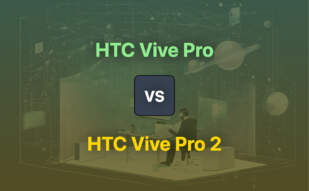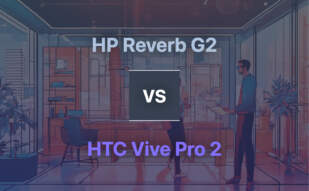HTC Vive Pro 2 is a high-resolution PC-tethered VR headset designed for professional and consumer use. It features integrated on-ear headphones, adjustable head harness, and compatibility with SteamVR and Viveport ecosystems. Requires additional base stations and controllers. Offers crisp visuals and adjustable settings for an immersive VR experience.

For those exploring options beyond HTC Vive Pro 2, alternatives include Vive Pro, Valve Index, Cosmos Elite, Reverb G2, Quest Pro, Quest 2, PSVR 2, Rift S, HP Omnicept, Pico 4, Quest 3, Pimax Crystal, and more.
Vive Pro
Offering an immersive experience replete with free 2-month Viveport Infinity membership, the Vive Pro 2 stands out among its peers as an optimal VR choice.
Vive Pro Top Features
- Seamless integration with Three.js JavaScript library
- GPU-accelerated 3D animations in web browsers
- Comprehensive features including effects, scenes, animation types, and more
- Full access to OpenGL Shading Language (GLSL)
| Feature | Benefit |
|---|---|
| Three.js Integration | Enrich your VR experience with animated 3D computer graphics |
| GLSL Access | Utilize high-level shader language to maximize visual output |
| Viveport Membership | Extended access to premium VR content |
Vive Pro Limitations
- API documentation still under development
- Requires understanding of JavaScript and WebGL for complete utilization
Vive Pro Use Cases
Use case 1: Web Developers
For those adept at JavaScript and WebGL, Vive Pro significantly enhances web-based 3D animations with GPU acceleration.
Use case 2: VR Enthusiasts
With its immersive features and integrated platform capabilities, Vive Pro offers VR enthusiasts rich, engaging experiences.
Use case 3: GLSL Programmers
Thanks to its access to OpenGL Shading Language (GLSL), Vive Pro allows GLSL programmers to fully exploit VR rendering capabilities.
Vive Pro 2
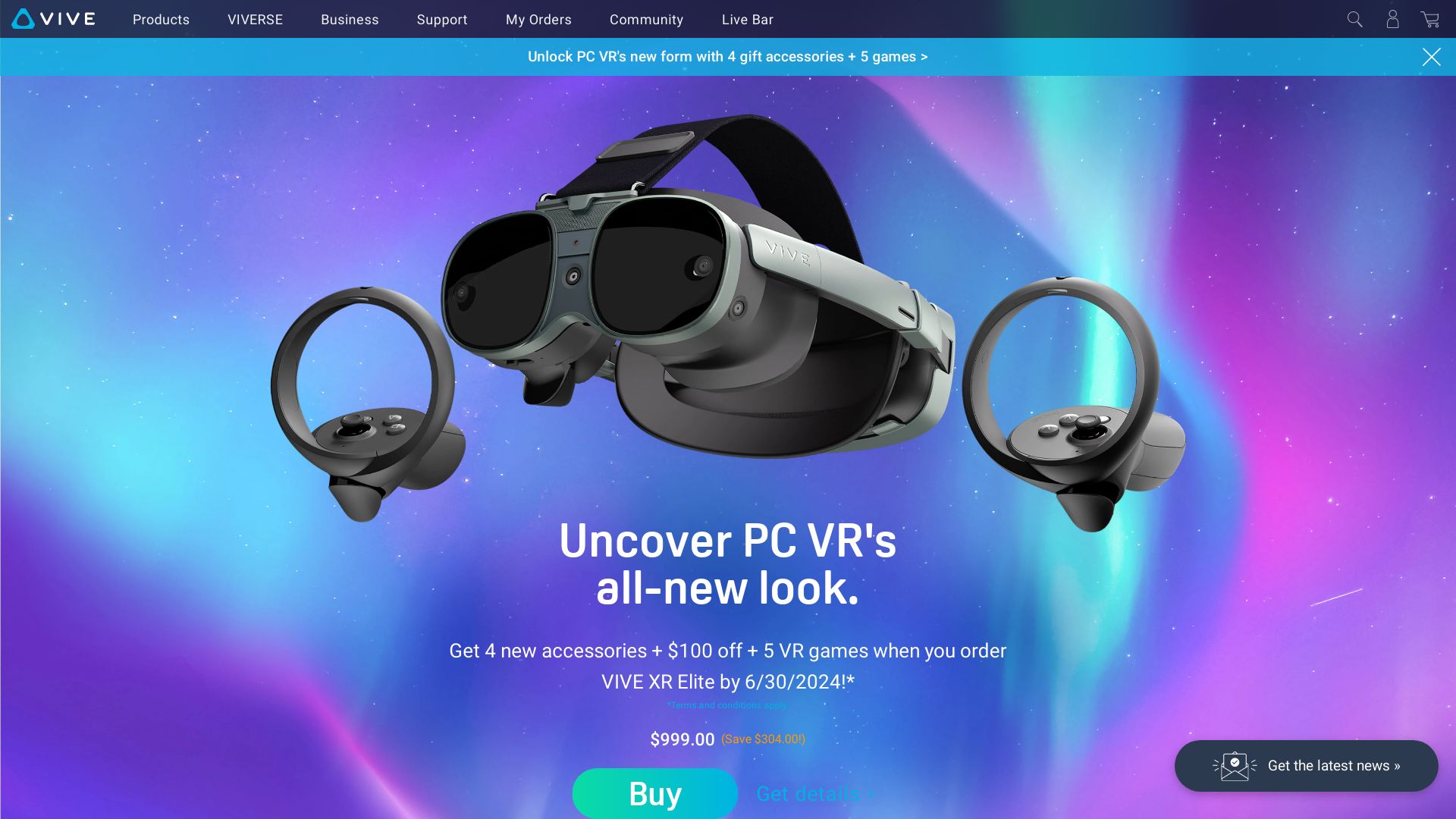
The Vive Pro 2 is a highly precise AR/VR headset, featuring sharp visuals, and bundled with a 2-month Viveport Infinity membership. Driven by three.js, a cross-browser JavaScript library, this device entirely omits the need for proprietary browser plugins, making it an immersive and user-friendly tool.
Vive Pro 2 Top Features
- GPU-acceleration for impressive 3D animations.
- Anaglyph, cross-eyed, and parallax barrier effects for spatial visuals.
- Incorporates Perspective and orthogonal cameras for accurate viewpoints.
- Different materials supported for varying light/texture effects like Lambert, Phong, and smooth shading.
- Over 150 coding examples provided for seamless implementation.
| Uses WebGL 2.0 | Offers better compatibility and advanced features. |
| Sourced on GitHub | Provides rights to inspect, modify and distribute the software. |
| Variable Controllers | Allows to manage the flow and state of the application. |
Vive Pro 2 Downsides
- No API documentation available, currently under construction.
- Requires a fair understanding of WebGL, Javascript, and 3D graphics.
Vive Pro 2 Pricing
The Vive Pro 2 headset pricing is variable depending on the chosen bundle. However, specifics are best checked on the official website due to occasional promotions and updates.
Vive Pro 2 Use Cases
Use case 1: Gaming Industry
The Vive Pro 2 with its high-quality graphics and immersive experience makes it an attractive choice for gamers who value realism and immersion.
Use case 2: Education
Institutions can utilize the Vive Pro 2 to create educational simulations, providing students with a virtual learning environment for better understanding.
Use case 3: Architecture
Architects may benefit from the Vive Pro 2‘s ability to create and visualize 3D drawings and models, thereby facilitating spatial understanding and improved design collaboration.
HP Omnicept
Enter the world of VR where privacy meets versatility with the HP Omnicept. This enterprise-focused, GDPR-compliant device is a stand-out in the bandwagon of VR headsets.
HP Omnicept Top Features
- High resolution: Boasting a pixel count of 2160×2160 per eye (4.7MP), this VR device heralds for immersive and clear visuals.
- API Integration: Possesses APIs for eye-tracking, pupillometry, Heart Rate alongside a Lower Face Camera, enhancing user interactions.
- Enhanced Privacy: Compliant with GDPR, the sensor data collected is not stored on the headset, securing user privacy.
- Auditory excellence: Inclusive of off-ear headphones and a microphone, ensuring a surreal audio-visual experience.
| Feature | Description |
|---|---|
| Robust Connectors | USB-C, DisplayPort, and Power with a 6m tracking cable |
| Headset Specifications | Superior Height, Width, Volume surpassing industry standards |
| Camera for Facial Animation | Captures real-time face movements to animate VR Avatars |
HP Omnicept Disadvantages
- Costly investment: With a price tag of $1,250, it may be out of buying reach for some consumers.
- Enterprise-focus: Hobbyists and enthusiasts might find the device overkill for their needs.
HP Omnicept Pricing
Marked at $1,250, the HP Omnicept targets premium, enterprise solutions. The device justifies the cost by providing a bevy of high-end features optimized for professional use.
HP Omnicept Use Cases
Use case 1: Enterprise Training
HP Omnicept excels in imparting realistic, immersive training scenarios, thereby enhancing team performance.
Use case 2: Collaboration
Seamlessly collaborate in real-time in a virtual space, breaking geographical barriers.
Use case 3: Creation and Well-being
Shape a healthy, creative and adaptive working environment via bio-sensing and AI analytics.
Pico 4
Launched in 2022 by ByteDance, the Pico 4 VR headset is a marketed as a creation of “balanced design, comfort, vivid and immersive VR experience”, in a conveniently small and impactful size.
Pico 4 Top Features
- Ergonomic design for evenly distributed weight
- Powered by Qualcomm Snapdragon XR2 and 8GB LPDDR4 RAM
- Enterprise variant offers LPDDR5 RAM, custom-built for businesses
- Motorized, automatic interpupillary distance adjustment
- Pico 4 visor has adjustable length from 255mm-310mm
| Specs/Features | Description |
|---|---|
| Weight | 295g without strap |
| Resolution | 2 Fast-LCD displays, over 2K resolution per eye |
| Field of View | 105° |
Pico 4 Downsides
- Limited game library as critiqued by NookGaming
- Smaller field of view due to Pancake lenses
Pico 4 Pricing
The Pico 4 VR headset is available for purchase at a price of €429 on Amazon and XRshop.
Pico 4 Use Cases
Use case 1: Immersive Entertainment
With its vivid and immersive VR experience, the Pico 4 makes for an excellent choice for gamers and home users looking for an enriched entertainment experience.
Use case 2: Business Solutions
The Pico 4 Enterprise variant, with its superior LPDDR5 RAM, caters excellently to the needs of businesses requiring high performance and stability.
Use case 3: Creative Designing
The high-resolution displays of Pico 4 can aid in detailed visual work, such as graphics and digital designing, offering creators a unique canvas to work with.
Meta Quest 3
Behold, the Meta Quest 3, the world’s first mass-market mixed reality headset, waiting to provide you with an immersive experience beyond the confinements of reality. Brace yourselves to plunge into a new world where fantasy and real-life intertwine. Preorders are now open for this technological marvel, due to hit the shelves on October 10, 2023.
Quest 3 Top Features
- Significant leap in visual resolution, a 30% increase compared to its predecessor, Quest 2.
- Enhanced audio range, 40% louder than Quest 2, providing incredibly clear, resonating sound.
- Slimmer profile with superior weight distribution for improved comfort and usability.
- Empowered by double graphics processing power, Snapdragon XR2 Gen 2 platform developed in collaboration with Qualcomm.
- The state-of-the-art 4K+ Infinite Display offers incredible visual clarity.
| Comfort | Audio | Resolution | Price |
|---|---|---|---|
| Redesigned with a thinner profile and a soft adjustable strap design. | An impressive 40% louder audio range compared to its predecessor, the Quest 2. | A stimulating 30% improvement in resolution compared to Quest 2, offering 25 pixels per degree and 1,218 pixels per inch. | Two models available: 128GB for $499.99 USD and 512GB for $649.99 USD. |
Quest 3 Disadvantages
One must note that complete detail of drawbacks is currently unavailable as the headset is forthcoming.
Quest 3 Pricing
Meta Quest 3 pricing commences from $499.99 USD for 128GB model, whereas, the 512GB variant is priced at $649.99 USD.
Quest 3 Use Cases
Use case 1: Gaming
The Meta Quest 3 is an optimum choice for gamers, with its incredible graphic capabilities, it can power augmented reality board games like Demeo, providing an engrossing gaming experience.
Use case 2: Fitness
Step into your new virtual gym with Meta Quest 3. It offers immersive fitness training experiences with applications like Xponential+.
Use case 3: Entertainment
Bring the stadium to your living room with Xtadium. Meta Quest 3 offers exhilarating sports-viewing experiences, amplifying your enjoyment to a whole new level.
Pimax Crystal
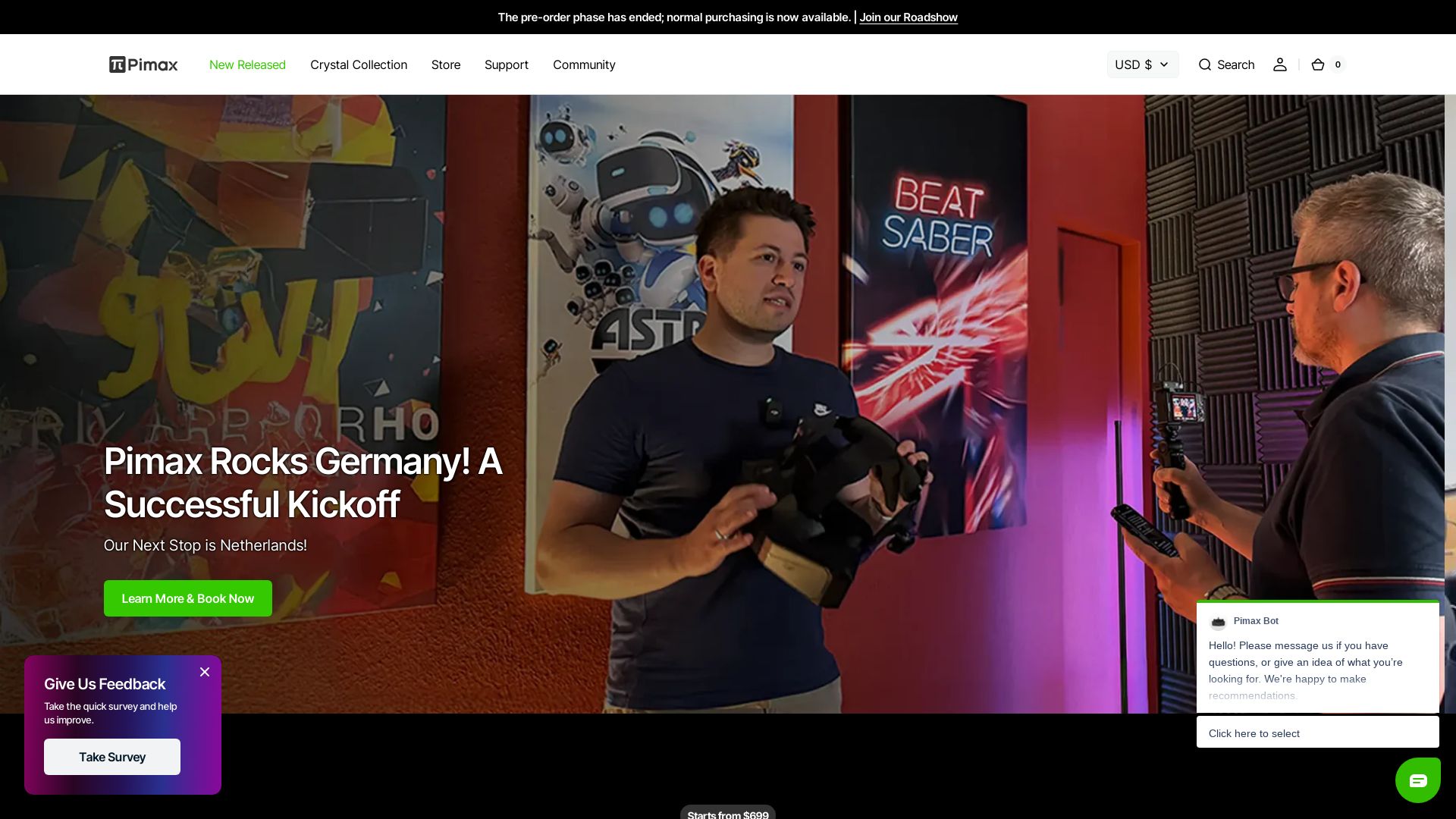
Introducing the Pimax Crystal, an ultra-clear VR headset equipped with glass aspheric lenses, offering the highest resolution in any consumer headset and an unmatched Pixels-Per-Degree (PPD) value for an immersive virtual experience.
Pimax Crystal Top Features
- Unrivaled Resolution: Boasts the highest resolution of any VR headset at 5760 x 2880 pixels.
- Enhanced Panels: Features QLED+Mini LED panels for a wider color range and purer black tones, adjustable through local dimming technology.
- High PPD: With a PPD of 35, it offers unmatched visual detail.
- Dual Modes: Offers two VR modes, PCVR or XR2 powered Standalone mode, for flexibility and convenience.
| Features |
|---|
| Highest resolution of any VR headset (5760 x 2880 pixels) |
| Local dimming technology for enhanced contrast |
| Dual mode operation (PCVR and Standalone VR) |
Pimax Crystal Downsides
- Some users reported comfort issues while using the headset.
- The standalone/streaming operation is currently not functional.
- Reported hand tracking issues in SteamVR.
Pimax Crystal Pricing
The Pimax Crystal comes at a price of $1,599, with the option of paying $73.79 per month for 24 months.
Pimax Crystal Use Cases
Use case 1: High-End Gaming
With unprecedented resolution and high PPD, the Pimax Crystal brings high-quality, immersive gaming experience to another level.
Use case 2: Professional Use
The exceptional clarity and high PPD make it suitable for professionals in fields that require precise visual detail, such as digital art or architecture.
Use case 3: XR Experiences
The Pimax Crystal’s dual-mode VR allows users to experience both tethered and standalone VR for extended reality (XR) experiences.
Vive
Enter the phenomenal world of Vive, a high-end VR headset, a powerful collaboration between the iconic Valve and HTC. Gifted with high-resolution screens and heart-stopping graphics, Vive is your vessel to vibrant, virtual vistas.
Vive Top Features
- High-resolution screens for an immersive visual experience.
- Powered by external computers or game consoles, ensuring a powerful performance.
- Innovative motion tracking enhances your interface with the immersive environments.
- Enjoy the freedom of movement in a 15 x 15-foot room with laser tracking system.
- Exclusive access to HTC Vive’s content library.
| Vive Pro 2 headset for upgraded experience | Valve Index Controllers for precise tracking |
| Large VR game library featuring games like Half-Life: Alyx and Beat Saber | Wide field of view at 120 degrees |
| Room-Scale tracking | Replacement option for on-ear headphones with USB-C headphones |
Vive Limitations
- Requires high-end, VR-ready PC for optimal user experience.
- Conventional wand-style controllers may feel awkward; Valve Index Controllers recommended for better experience.
- Pre-launch price could be a factor for some at $799.
Vive Pricing
The Vive headset comes at an investment of approximately $799, a price reflective of its premium features. Note, a VR-ready PC may be an additional cost around $1,000.
Vive Use Cases
Use case 1 – Gaming
With its enhanced motion tracking and a robust game library, Vive transmutes your room into the heart of the most exhilarating gaming experiences.
Use case 2 – Virtual Exploration
With high-resolution 5K screens and wide field of view, voyage through realistic, captivating virtual realities, unravelling the unseen or revisiting the familiar.
Use case 3 – User-Interface Design
Leverage Vive’s advanced motion tracking to refine user interfaces. Design and test in a room-scale 3D environment with immediate, motion-based feedback.
Valve Index: Unchain the Shackles of Clichés

Meet your new tech rebel: Valve Index. A transformative second-gen VR headset, intensifying the VR experience to unimaginable realms. Unveiled by Valve on June 28, 2019, this maverick headset shook the status quo.
Features that Rattle VR Conventions
- Stunning dual 1440 x 1600 RGB LCDs, dwarfing OLED with 50% more subpixels for an unparalleled visual adventure.
- Revolutionary reduced illumination period of 0.33ms to 0.53ms – your one-way ticket to superior motion clarity.
- Radical frame rates of 80/90/120/144Hz, the nemesis of VR uncomfortability during extended play sessions.
- Phenomenal FOV optimization with user-adjustable optics, offering visionaries 20 degrees more than the HTC Vive.
- Innovative off-ear audio solution for comfort and sound quality that soothes instead of jarring.
| Operating Systems | Windows, Linux |
| Ergonomics | Adjustable head size, face angle, eye relief (FOV), and IPD with antimicrobial fabric |
| Controllers | Upgrades gaming using 87 sensors to track hand and finger positions |
Limitations of the Valve Index
- The quest for tactile feedback remains elusive.
- Steep price tag may bar some VR enthusiasts.
- No eye tracking; an exclusion contrary to emerging trends.
- Room-scale sensor setup can test your patience.
Pricing
Prepare to shell out $799 for the headset alone, nostalgia for the introductory price of $999. Fancy the full kit? It requires a smooth $999.
Valve Index Use Cases
Professional Training
Advocates immersive training, equipping professionals with a realistic, interactive environment without real-world risks.
Education
Reinforces the teaching process through visualization and engagement, blurring the lines between learning and exploration.
Healthcare
Serves as a potent tool in therapy and rehabilitation, aiding patient recovery like the maverick healer it is.
Cosmos Elite
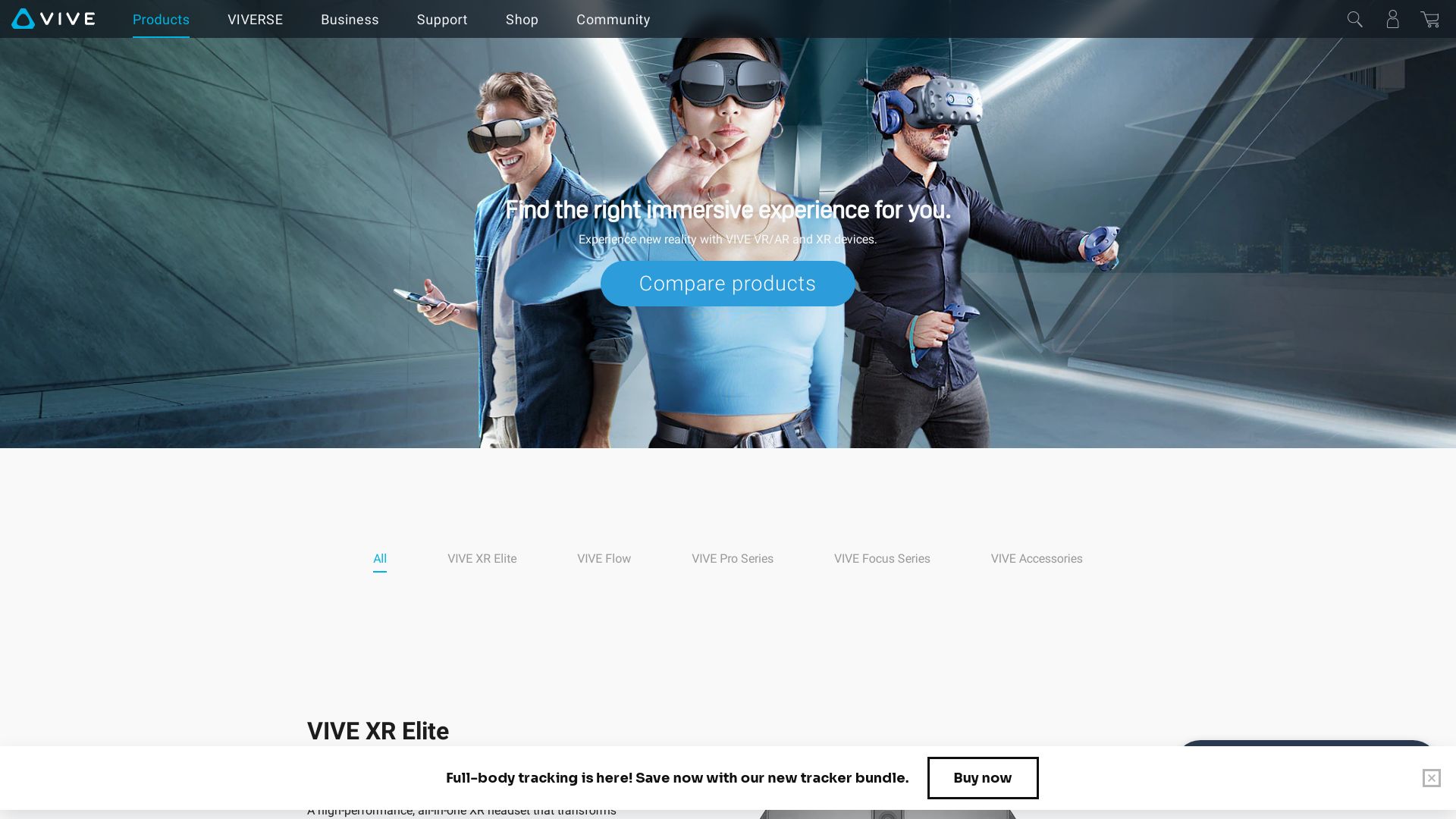
Experience the fusion of comfort, versatility, and power with the Cosmos Elite, a premium VR headset by HTC Vive. Despite residing in the middle ground between high-end and portable VR solutions, this device delivers a robust and diverse VR experience.
Cosmos Elite Top Features
- Distinction in comfort with soft padding, adjustable strap, and dial-in for fit tightness.
- Dual high-res 1440-pixel display panels for an immersive visual experience.
- Flip-up front panel for quick and convenient exit from VR.
- Built-in headphones for optimum game audio and voice chat capabilities.
- Outstanding performance in high-end games, tested with a powerful RTX 2070 graphics card.
| Specifications | Features |
|---|---|
| Resolution | Dual 3.4” LCD screens, each 1440 x 1700 pixels |
| Field of View | Max 110-degree field of view |
| Build quality | High-quality plastic adjustable headband |
| Sound Quality | Built-in headphones |
Cosmos Elite Limitations
- Requires ample space and complicated setup due to space and cables.
- Imperfect controller tracking that deteriorates near the sensor borders.
- High cost at $899/£899, which is double the Oculus Quest 2.
- Demands user’s previous VR knowledge for setup.
Cosmos Elite Pricing
The Cosmos Elite is a premium VR option priced at $899/£899, which is a substantial investment compared to some of its competitors in the VR sphere.
Cosmos Elite Use Cases
Use case 1: High-end gaming
With its exceptional performance in high-end games, Cosmos Elite is truly a game changer for fans of VR gaming. Games such as Half-Life: Alyx and Beat Saber come alive in an entirely new manner.
Use case 2: Social VR experiences
For those who love to engage in social VR experiences, Cosmos Elite offers a new dimension of interaction. Connect and interact in environments like Rec Room with an enhanced sense of presence and immersion.
Use case 3: Graphic design and productivity
Cosmos Elite’s high pixel count and clear resolution make it a powerful tool for graphic design and productivity software, contributing to more precise and realistic creations.
Reverb G2
Enter the world of immersion with the consumer-centric Reverb G2, a virtual reality headset by HP engineered for Windows Mixed Reality. It’s an overhaul of HP’s original 2019 Reverb, with thoughtful upgrades in comfort and motion detection.
Reverb G2 Top Features
- High compatibility with both SteamVR and Windows Mixed Reality, making it suitable for multiple gaming platforms.
- Stunning display resolution of 2160 x 2160 pixels at 90Hz, providing sharp images.
- Comes with two improved motion controllers. No sensors or beacons needed since the tracking is camera-based.
- Simplified setup via Windows Mixed Reality portal.
- Comfortable wear, thanks to the memory foam lined facemask that is also washable.
| Feature | Description |
|---|---|
| Visor Slider | Allows adjustment for pupillary distance. |
| Inclusion of Adapters | Comes with DisplayPort-to-mini-DisplayPort and USB-C-to-USB-A adapters. |
| Build | Full cloth build with 4 external cameras for motion tracking. |
Reverb G2 Limitations
- Lower resolution compared to other headsets such as Oculus Quest 2 and Valve Index.
- Has occasionally reported hiccups with camera-based motion tracking that can distort controller movements.
- The interface may present challenges due to issues with Windows Mixed Reality platform.
Reverb G2 Pricing
Priced slightly cheaper than its competitors at $599.99, the Reverb G2 comes across as a cost-effective alternative to the Valve Index and HTC Vive Pro 2. However, it’s more expensive than the standalone Oculus Quest 2.
Reverb G2 Use Cases
Use case 1: Gaming
With compatibility with games like Aim Lab VR, Nvidia VR Funhouse, Project CARS Pagani Edition, and VRChat, the Reverb G2 delivers an immersive gaming experience.
Use case 2: VR Development
The Reverb G2 offers a suitable platform for VR developers, thanks to its compatibility with SteamVR and the Windows Mixed Reality system.
Use case 3: PC-focused VR Experiences
For those seeking a powerful, PC-focused VR experience, Reverb G2’s compatibility with high-end graphic processors like Nvidia GeForce 1080 or AMD Radeon 5700 GPU, makes it a fitting choice.
Quest Pro
The Quest Pro is a VR/AR headset from Meta, specifically designed for professional users, presenting a perfect balance of elegance, functionalities, and superior specifications.
Quest Pro Top Features
- Sleek design with glossy black front panel
- Five cameras for tracking and resolution: 3 front-facing, 2 side-facing
- Redesigned motion controllers: Lighter and less burdening with inbuilt rechargeable batteries
- Charging cradle included with recesses for headset and controllers
- High-definition resolution of 1,920 x 1,800 pixels per eye
- Features face and eye tracking calibration
- Powered by Snapdragon XR2+ processor
| Feature | Description |
|---|---|
| Memory and Storage | 12GB RAM and 256GB storage |
| Software | Meta Horizon Worlds and customizable interfaces |
| Accessories | Rubber protective cover to guard VR headset |
Quest Pro Limitations
- Unpadded headset can lead to discomfort
- Features are limited for consumer-focused software
- Peripheral vision gets exposed, possibly leading to disturbance during usage
Quest Pro Pricing
With a retail price of $1499.99, the Quest Pro is spike ahead of its predecessor, Meta Quest 2. This pricing highlights its intended audience as professionals with specific VR/AR needs.
Quest Pro Use Cases
Use case 1
The Quest Pro is more suitable for enterprise users, as it offers integrations for workflows and provides collaborative work platforms with its customisable interfaces.
Use case 2
It’s also highly valuable to professionals involved in heavy graphics work or requiring real-world and virtual blends as it leverages an upgraded Snapdragon XR2+ processor and its virtual/mixed reality capabilities.
Use case 3
Apart from gaming, Quest Pro is efficacious for training and simulation-based applications in various industries like aviation and healthcare because of its superior resolution and tracking accuracy.
Quest 2
Born from the technological cradle of Reality Labs, a division of Meta Platforms, the Quest 2 is Meta’s VR headset offering updated specifications and online services, such as the Quest Store. Originally christened Oculus Quest 2 before undergoing a brand change as part of the Meta transition, it was released on October 13, 2020 and heralded a shift from PC-based VR strategies. A successor, Quest 3, is anticipated for a fall 2023 launch.
Quest 2 Top Features
- Processor: Powered by a Qualcomm SnapDragon XR2 processor
- Resolution: Enhanced visual experience with 1832 x 1920 per eye
- Storage capacity: Accessible in 128GB and 256GB storage variants
- Independent functionality: Can operate standalone or in sync with Oculus Rift-compatible VR software
- Game library: Associated with the Quest Store that broadens the VR reality scope with numerous games and experiences
| Feature | Description |
| Sound | Pair of built-in speakers and 3.5 mm headphone jack for immersive sound experience |
| Controller | Improved Oculus Touch controllers that support hand tracking and come with longer battery life |
| Display | Enhanced refresh rate from original 72Hz to 120Hz |
Quest 2 Limitations
- Brief Battery life: Endures only between 2 and 3 hours between charges
- Original 64GB model discontinued: The 64GB offering has been dropped, leaving the 128GB and 256GB options
- Age restrictions: Meta accounts on Quest 2 and 3 are available for ages 10 and above
Quest 2 Pricing
The Quest 2 VR headset is priced at $299 for the 64GB model, and $399 for the 256GB variant. This competitively priced device provides a compelling alternative to other VR offerings in the market.
Quest 2 Use Cases
Use case 1
Quest 2 is an excellent choice for VR gamers seeking a standalone, Android-based VR system. It provides an extensive library of games and experiences via the Quest Store and is supported by the powerful SnapDragon XR2 processor.
Use case 2
This device is suitable for users who want the flexibility to use their VR headset independently, or connected to a desktop computer, thereby harnessing the power of Oculus Rift-compatible software.
Use case 3
The Quest 2 is an ideal choice for tech enthusiasts wanting to experience high-quality VR with an impressive 1832 x 1920 resolution per eye, a higher refresh rate, and immersive sound experience with the in-built speakers and headphone jack.
PSVR 2
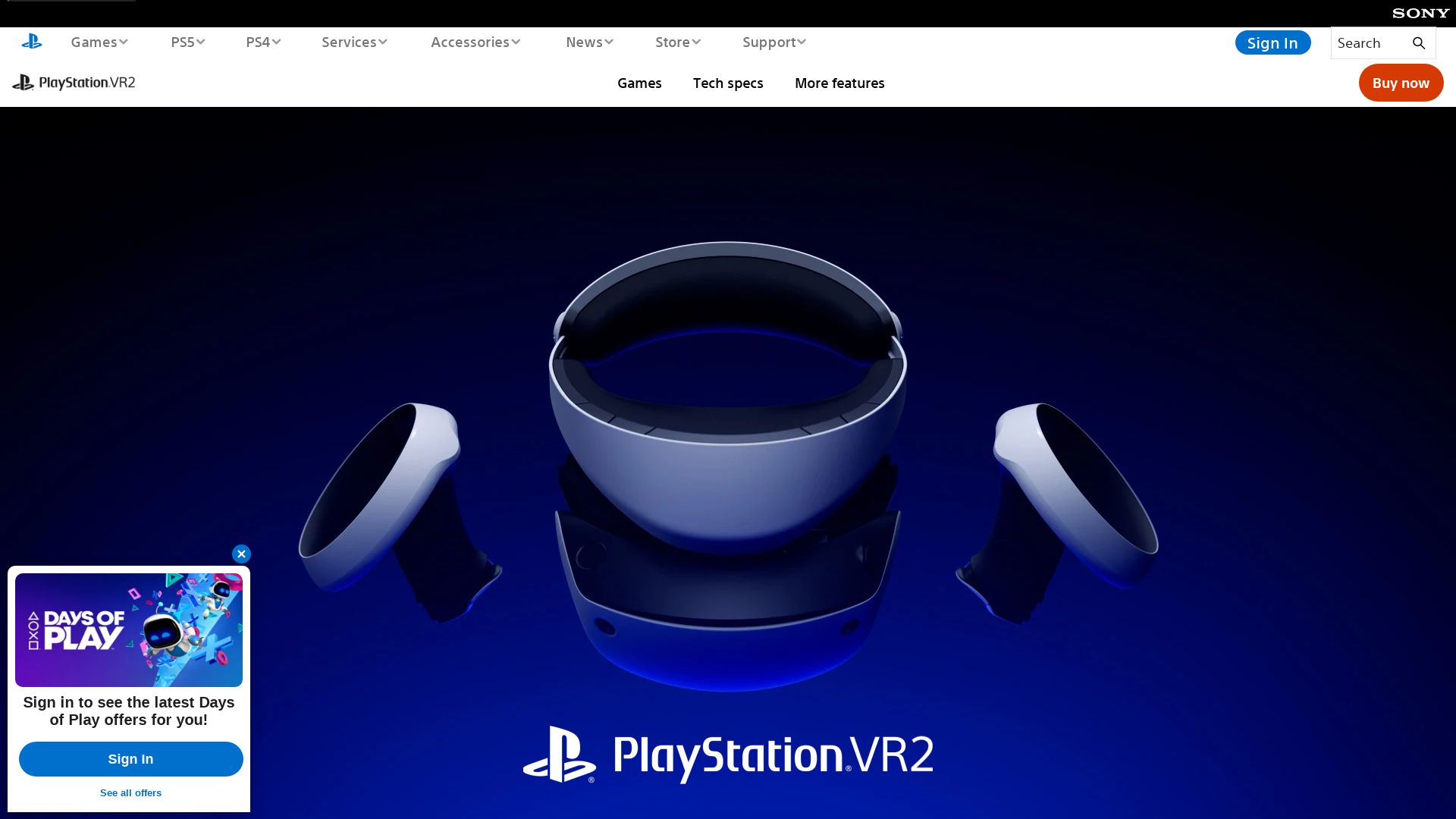
Prepare for a virtual reality makeover with the new PSVR 2. Designed by Sony, this next-gen portable VR headset proclaims a seismic upgrade, offering a superior immersive experience in the world of virtual reality.
PSVR 2 Top Features
- Advanced Upgrade: Evolving from PSVR 1, PSVR 2 stands as a mammoth upgrade, offering impressive specs.
- Display improvement: With a resolution of 2,000 x 2,040 per eye, it offers a lifelike immersive VR experience.
- Expanded Field of View: An approximate field of view of 110 degrees enables a more realistic perception of the virtual world.
- Enhanced Controllers: The revamped Sense controllers deliver a robust and engaging gaming experience.
- Inside-out Tracking and Eye-tracking: Elevates the immersive feel and realism to new heights, contributing to a seamless VR experience.
| Feature | Description |
|---|---|
| No need for external tools: | Plugs directly into PlayStation 5, freeing up the need for additional processor boxes and external cameras. |
| Comfort and ergonomics: | Personalized fit and comfort with adjustable lenses and lightweight yet sturdy design for a fatigue-free VR experience. |
| High Refresh rate: | Promises a smooth operating speed with refresh rates of up to 120Hz. |
PSVR 2 Disadvantages
- Steep Price Tag: High cost, especially when considering the required PlayStation 5 prerequisite and any potential accessory purchases.
- Limited Backward Compatibility: Lacks backward compatibility with previous PSVR titles, with only a handful of VR games available for the new platform.
- Battery Life: High-end features and functionalities could lead to rapid battery consumption.
PSVR 2 Pricing
At a price tag of $549.99/£529.99, PSVR 2 is a premium investment for true VR aficionados. Remember, this doesn’t include the required PlayStation 5 or any potential accessory purchases.
PSVR 2 Use Cases
Use Case 1: VR Gaming
Championing a leaps-and-bounds advance over its predecessor, the PSVR 2 provides a bedazzling, immersive VR gaming experience with its high-end specs and engaging haptic feedback.
Use Case 2: Home Entertainment
Elevate your home entertainment experience with the PSVR 2’s brilliant 4K visuals and vibrant HDR-supported display. Engage in a near-realistic immersive experience while watching movies or concerts.
Use Case 3: Professional Training
Leveraging the PSVR 2’s eye-tracking and inside-out tracking capabilities, professionals can reap benefits from high-quality VR training simulations, particularly in fields such as healthcare, aviation, and military.
Rift S
Developed by Facebook Technologies and Lenovo, Rift S is an evolved version of the original Oculus Rift. Launched in 2019, this high resolution, inside-out positional tracking VR device has been recognized for its comfort and ease of setup. It should be noted, however, that it has attracted mixed reviews, with some critiques focused on its incremental upgrade over the Oculus Rift.
Rift S Top Features
- High-resolution display: Offers a display of 2560×1440 (1280×1440 per eye) at 80Hz refresh rate for clearer and sharper visuals.
- Optimized tracking: Utilizes Oculus Insight, with 5 built-in cameras for precise room-scale tracking, facilitates more immersive gaming.
- Field of View: Provides a 115° field of view.
- Ergonomic design: Comfort optimized with Lenovo designed halo headband, allowing better weight distribution.
- Oculus Touch controllers: Redesigned for inside-out tracking.
| Feature | Description |
|---|---|
| Adjustable IPD | This allows adjustments via software as it uses a single screen. The fixed lens IPD is 63.5mm, software adjustable from 61.5mm to 65.5mm. |
| Integrated Speakers | Built with integrated speakers, it also includes a 3.5mm Stereo headphone jack for immersive audio. |
| Compatibility | It’s compatible with Oculus Store, Viveport store, and Steam VR, opening an array of VR experiences. |
Rift S Limitations
- Only an incremental upgrade over the original Oculus Rift.
- Described as Oculus’ “gold standard” yet it has mixed reviews.
- Production ceased in June 2021, raising questions about after-sales support and availability
Rift S Pricing
At a cost of $399, the Rift S forms a mid-range option in the VR headset market.
Rift S Use Cases
Use case 1: Gaming
With its Oculus Insight tracking technology, the Rift S offers a highly immersive gaming experience. Its compatibility with multiple stores ensures access to a variety of games and VR content.
Use case 2: Interactive Learning
The high-resolution display and precise tracking make the Rift S an excellent tool for interactive and engaging learning experiences.
Use case 3: Virtual Tours
Given its 115° field of view, the Rift S can be used for virtual tours, such as virtual real estate walkthroughs, enhancing user experience with its realistic representation.
Hannah Stewart
Content writer @ Aircada, tech enthusiast, metaverse explorer, and coffee addict. Weaving stories in digital realms.



